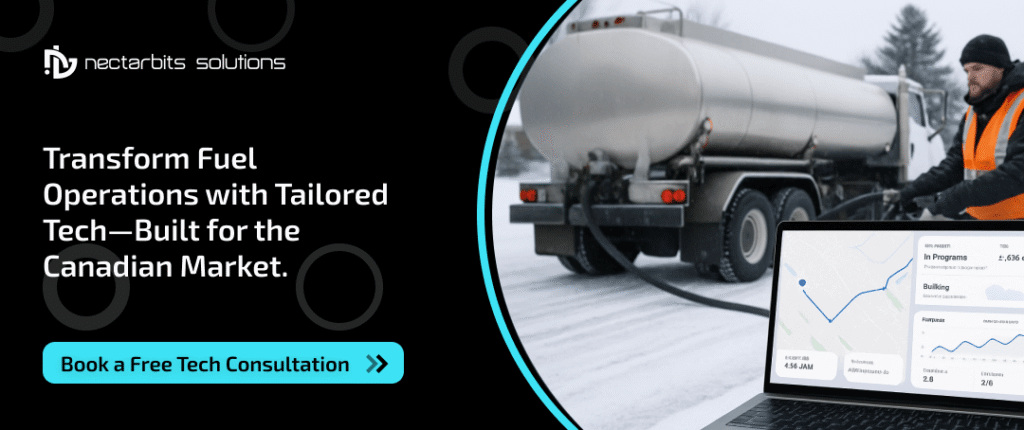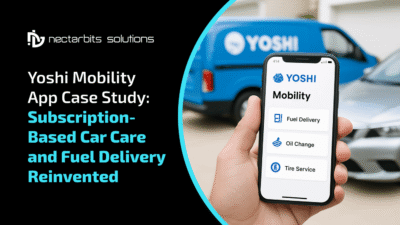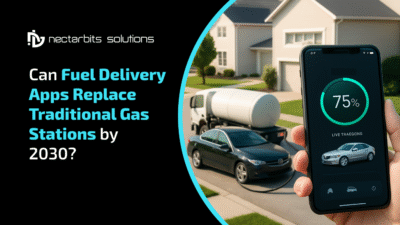Every time you fill up your car or a delivery truck reaches its destination on time, you’re witnessing the fuel industry in action. It powers every sector across Canada—from transportation and agriculture to construction and energy. However, the backbone of our economy operates under immense pressure. Market volatility, supply chain disruptions, environmental regulations, cyber threats, and labour shortages all test the resilience of fuel businesses daily.
In today’s high-stakes environment, relying solely on traditional strategies is no longer enough. To stay ahead, Canadian fuel companies must embrace smart, tech-driven solutions that enhance efficiency, sustainability, and compliance.To address these demands, many businesses are exploring custom software development solutions tailored to the Canadian landscape.
This blog explores the top five challenges fuel businesses face and how technology is reshaping the industry to overcome them—improving operations, reducing risk, and driving growth across Canada.
Challenge 1: Volatile Market Prices and Demand Fluctuations
The Problem
The Canadian fuel market is highly sensitive to global shifts. Wars, pandemics, and trade conflicts can trigger dramatic price changes. These fluctuations complicate demand forecasting, inventory management, and pricing strategies. With different consumption trends across cities like Toronto, Calgary, and Yellowknife, local demand can swing unexpectedly.
Relying on spreadsheets and historical averages is no longer sufficient. Businesses face overstock risks, under-delivery penalties, and reduced profit margins when miscalculating market trends.
How Technology Solves It
AI-Powered Forecasting
Machine learning models analyze data from multiple sources—historical fuel usage, weather patterns, tourism cycles, and more. This helps Canadian fuel suppliers accurately forecast demand and optimize procurement, inventory, and pricing.Solutions like those from a software development company in Vancouver can enable AI-powered forecasting tailored to Canadian markets.
Real-Time Market Dashboards
Advanced analytics platforms offer live visibility into pricing trends, supply fluctuations, and field-level inventory. Businesses can adjust in real-time to reduce waste and increase profitability.
Challenge 2: Supply Chain Disruptions and Logistics Inefficiencies
The Problem
Canada’s geography poses a major challenge. Harsh winters, remote delivery zones, and limited infrastructure slow down fuel transportation. Missed deliveries can result in downtime, lost revenue, and client dissatisfaction.
Unoptimized delivery routes, idle vehicles, and lack of visibility into fleet operations further drain resources.
How Technology Solves It
IoT and Fleet Monitoring
By installing IoT sensors on fuel trucks and storage tanks, companies gain visibility into real-time vehicle location, tank levels, and driver behaviour. Alerts help detect leaks or route delays, enabling faster response times. Discover integrated IoT fleet monitoring in fuel delivery apps for the fuel industry.
AI-Based Route Optimization
AI algorithms evaluate live traffic, road conditions, and weather to plan the most efficient routes. This is particularly impactful for regions with long-haul requirements like Saskatchewan or Northern Ontario.
Blockchain for Supply Chain Transparency
Blockchain secures transaction data across the fuel journey—from refinery to end-user. It creates an auditable, tamper-proof record that increases trust and simplifies compliance audits.
Challenge 3: Stringent Regulatory Compliance and Environmental Pressures
The Problem
Fuel businesses across Canada operate under a patchwork of provincial and federal regulations. With carbon pricing schemes in provinces like BC and Quebec, along with evolving clean fuel standards, compliance management becomes increasingly complex.
Manual reporting processes consume valuable time and increase the risk of human error, fines, or reputational damage. On top of that, investors and customers are placing greater emphasis on environmental responsibility and ESG reporting.
How Technology Solves It
Automated Compliance Software
Cloud platforms automatically track and update changes in provincial and federal fuel regulations. Businesses can generate accurate reports, flag compliance gaps, and reduce time spent on paperwork.
Environmental IoT Monitoring
Sensors placed near storage tanks or fuel stations can track air quality, groundwater contamination, and fuel leakage. Early alerts enable immediate corrective actions before regulatory violations or environmental damage occur.
Digital Twin Simulations
Digital replicas of fuel operations help simulate changes in supply chain behaviour, emissions, or system performance. Businesses can test different strategies before implementing them in real-world settings.
Challenge 4: Cybersecurity Threats
The Problem
Digitization has improved operational efficiency but has also exposed fuel businesses to increased cyber risk. Incidents like ransomware attacks on pipelines have shown how vulnerable fuel infrastructure can be.
Legacy systems often lack strong cyber defenses. Insecure control rooms, outdated software, and poor employee training all contribute to security vulnerabilities.
How Technology Solves It
AI-Driven Threat Detection
AI security systems scan for anomalies in network behaviour. They can automatically isolate threats, prevent data breaches, and protect control systems in real time.
Zero Trust Security Frameworks
Modern cybersecurity frameworks restrict access even within internal networks. Every device, user, and application must be verified—minimising unauthorised access and internal threats.
Employee Awareness Training
Gamified cyber training modules teach employees how to recognise phishing, avoid risky downloads, and report suspicious activity. These tools are scalable across teams, from dispatchers to field operators.
Challenge 5: Talent Shortages and Workforce Development
The Problem
Canada’s fuel sector faces an ageing workforce, skill shortages, and a lack of interest from younger professionals. Recruiting and retaining skilled drivers, technicians, and compliance officers has become a growing challenge.
Moreover, current staff need constant upskilling to adapt to changing technologies and safety standards.
How Technology Solves It
Microlearning for Field Teams
Short, interactive training modules delivered via mobile devices help workers upskill without needing to leave the job site. This is ideal for remote or shift-based workforces.
AI-Powered Knowledge Assistants
Generative AI tools can answer field-level queries in seconds. Whether it’s troubleshooting equipment or clarifying a regulation, staff can access knowledge instantly—reducing dependence on senior personnel.
Automation and Remote Robotics
For dangerous or remote tasks like fuel tank inspections or line flushing, robotic tools can reduce injury risk while addressing labour shortages.
Virtual Reality Training
VR training simulations offer immersive environments for workers to practice emergency response, safety procedures, and compliance protocols without real-world hazards.
Conclusion
The Canadian fuel industry is at a crossroads. Shifting market forces, climate accountability, rising cyber threats, and workforce constraints make operating in this sector more complex than ever. Traditional practices are not enough to stay resilient.
Forward-thinking fuel businesses are turning to technology to unlock efficiencies, meet regulations, improve safety, and deliver superior customer service. Whether it’s predictive analytics, route optimization, compliance automation, or v deirtual training, the tools exist today to modernize operations for a stronger tomorrow.

FAQS
1. What are the biggest challenges facing fuel businesses in Canada today?
Fuel companies across Canada face several key challenges, including market price volatility, supply chain disruptions, strict environmental regulations, growing cybersecurity risks, and skilled labour shortages. These issues impact everything from profitability to customer service and long-term sustainability.
2. How can technology help manage fuel price fluctuations?
Technologies like AI and machine learning can analyze historical data, economic trends, weather conditions, and local demand to forecast fuel usage. This allows businesses to optimize procurement, inventory, and pricing strategies to maintain profitability even during market instability.
3.What role does IoT play in fuel logistics optimization?
IoT devices, such as sensors on fuel trucks and storage tanks, provide real-time data on location, fuel levels, driver behaviour, and more. This improves fleet visibility, helps reduce delivery delays, and supports proactive decision-making across Canada’s vast and diverse geography.
4. Why is regulatory compliance so challenging in the Canadian fuel sector?
Canada has a complex regulatory environment, with different carbon pricing systems and environmental standards at the federal and provincial levels. Manually tracking changes and maintaining compliance can be time-consuming and prone to error, especially for companies operating in multiple regions.
5. How does automation help with environmental compliance?
Automation platforms monitor environmental regulations in real time, generate compliance reports, and alert businesses to potential violations. Paired with IoT sensors, these systems detect spills or leaks early, helping fuel businesses avoid fines and protect the environment.
6. What cybersecurity threats do fuel companies face?
Fuel businesses are increasingly targeted by ransomware, phishing, and infrastructure attacks. These threats can shut down fuel delivery operations, compromise customer data, and damage business reputation. Legacy systems without modern cybersecurity protocols are especially at risk.
9. Can small or medium fuel companies afford these technologies?
Yes, many of these technologies are available as scalable SaaS solutions with subscription-based pricing. Canadian fuel businesses can adopt them gradually, starting with critical needs like route optimization or compliance automation, then expanding over time.
10. How can I get started with digital transformation in my fuel business?
Start by identifying your most pressing challenge—such as route inefficiencies, compliance complexity, or security gaps. From there, explore digital platforms that offer targeted solutions. Partnering with a tech provider familiar with the Canadian fuel industry can speed up implementation and ensure ROI.




